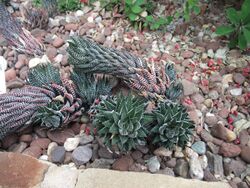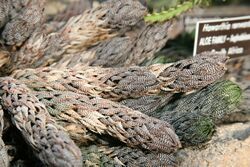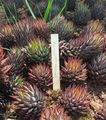Biology:Haworthiopsis reinwardtii
| Haworthiopsis reinwardtii | |
|---|---|

| |
| Scientific classification | |
| Kingdom: | Plantae |
| Clade: | Tracheophytes |
| Clade: | Angiosperms |
| Clade: | Monocots |
| Order: | Asparagales |
| Family: | Asphodelaceae |
| Subfamily: | Asphodeloideae |
| Tribe: | Aloeae |
| Genus: | Haworthiopsis |
| Species: | H. reinwardtii
|
| Binomial name | |
| Haworthiopsis reinwardtii (Salm-Dyck) G.D.Rowley[1]
| |
| Synonyms[1] | |
| |
Haworthiopsis reinwardtii, formerly Haworthia reinwardtii, is a species of succulent flowering plant in the family Asphodelaceae, native to the Eastern Cape Province of South Africa . It is one of the species of Haworthiopsis that is commonly cultivated as an ornamental.
Description
It is a perennial succulent, with stems growing to 20 cm (8 in)in height, with a basal rosette of white-spotted fleshy leaves arranged in a spiral pattern, and racemes of tubular pinkish-white flowers in spring. The plant spreads to form a mat, by means of freely-produced offsets, also a convenient means of propagation.[2]
It is frequently confused with Haworthiopsis coarctata – a closely related species which occurs just to the west of this species' natural range and looks very similar. However H. reinwardtii has larger, flatter and whiter tubercles on its leaves (those of H. coarctata are smaller, smoother and rounder). H. reinwardtii also has thinner, narrower leaves.[3]
Varieties
This variable species has a large number of recognised varieties, some of which are depicted below:
Cultivation
H. reinwardtii requires very well-drained soil and some exposure to sun. It does not tolerate prolonged exposure to temperatures below 10 °C (50 °F), so in temperate regions it must be grown under glass with heat. It has gained the Royal Horticultural Society's Award of Garden Merit.[4]
References
- ↑ 1.0 1.1 "Haworthiopsis reinwardtii". World Checklist of Selected Plant Families. Royal Botanic Gardens, Kew. http://wcsp.science.kew.org/namedetail.do?name_id=490824.
- ↑ RHS A-Z encyclopedia of garden plants. United Kingdom: Dorling Kindersley. 2008. pp. 1136. ISBN 978-1405332965.
- ↑ "All you wanted to know about Haworthias, Gasterias and Astrolobas: Haworthia reinwardtii". http://haworthia-gasteria.blogspot.com/2008/02/haworthia-reinwardtii.html.
- ↑ "RHS Plant Selector - Haworthia reinwardtii". https://www.rhs.org.uk/Plants/8281/Haworthia-reinwardtii/Details.
- (Salm-Dyck) Haw., Saxifrag. Enum. 2: 53 (1821).
Wikidata ☰ Q42961782 entry
 |







